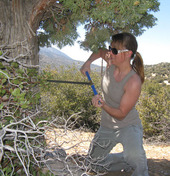Highlight
IGERT Trainee Laci Gerhart's Research Generates Commentary in New Phytologist
Achievement/Results
IGERT Trainee Laci Gerhart published her second paper in 2010 in the refereed journal, New Phytologist (188(1):63–69). The paper, “Glacial trees from the La Brea tar pits show physiological constraints of low CO2,” focused on an analysis of the El Niño Southern Oscillation (ENSO) climate pattern. Though the ENSO directly affects only the tropics, indirect effects on temperature and precipitation are experienced throughout the globe. Significant progress has been made in understanding current ENSO activity, but the behavior and effects of ENSO under altered environmental conditions (both past and future) is not known. In southern California, El Niño conditions produce a warmer and wetter growing season, resulting in increased growth of juniper trees and altered chemical make up of wood deposited in annual rings. This study analyzes the width and chemical signature of rings from juniper trees preserved in the La Brea tar pits to determine the strength and frequency of El Niño years throughout the last 50,000 years. Growth patterns of glacial-aged and modern trees in El Niño and non-El Niño years were analyzed to assess how these climatic patterns affected tree growth.
Address Goals
This paper generated commentary (DT Tissue & JD Lewis. (2012) “Learning from the past: how low [CO2] studies inform plant and ecosystem response to future climate change,” New Phytologist, 194(1):4-6) which suggested directions for future research on the subject: “Overall, a major conclusion of Gerhart et al. was that the environmental factors that regulate photosynthesis, and indirectly plant growth, may vary across geologic time” (p. 6). Gerhart’s work builds on previous research done by Professor Joy Ward on the effects of increased CO2 on plants and will advance understandings of global climate patterns on the growth of plants.






